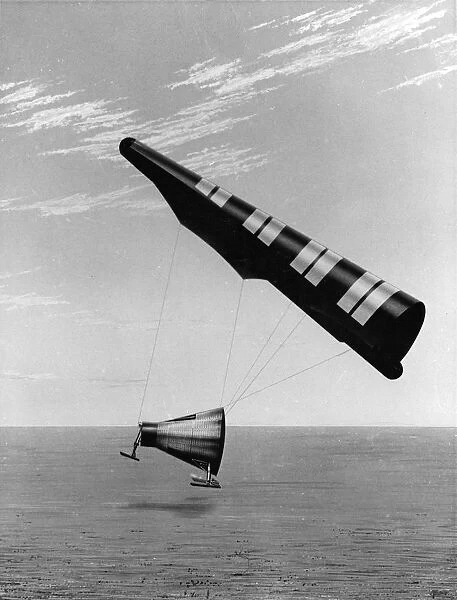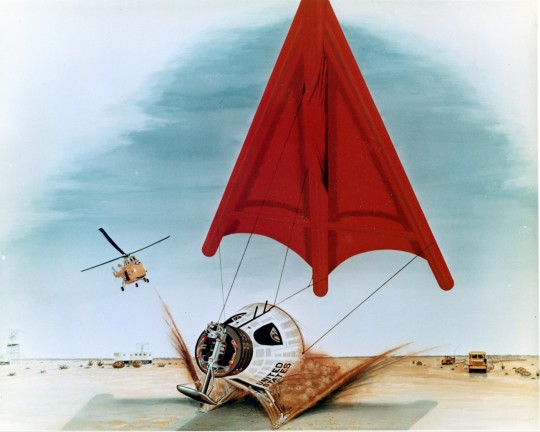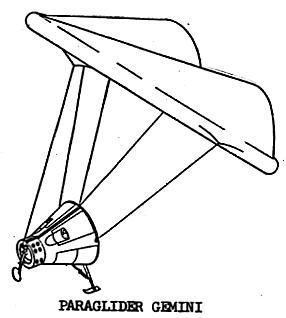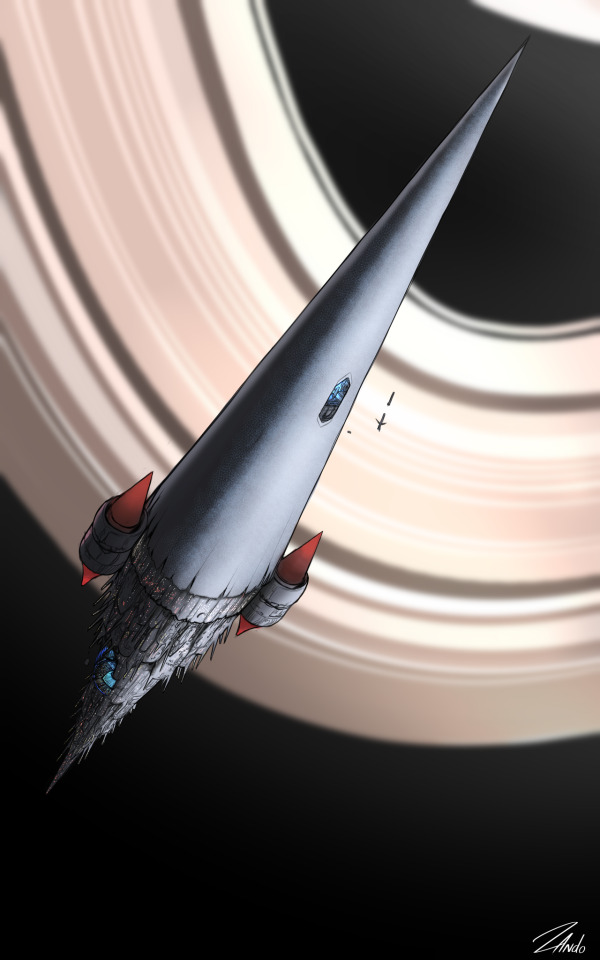Don't wanna be here? Send us removal request.
Text
Since this is real it doesn't really need a category, but it's very cool and didn't make it to actual use so....
Plausible.


"American manned spacecraft. The paraglider was supposed to be used in the original Gemini program but delays in getting the wing to deploy reliably resulted in it not being flown.

"Orbiting Stations: Stopovers to Space Travel" by Irwin Stambler, G.P. Putnam's Sons, 1965
Status: Flown 1963. Thrust: 706 N (158 lbf). Gross mass: 3,800 kg (8,300 lb). Unfuelled mass: 3,345 kg (7,374 lb). Specific impulse: 273 s. Height: 5.67 m (18.60 ft).

McDonnell proposed that additional Gemini missions be flown to fully test the paraglider, which was planned for the follow-on Big Gemini.

Crew Size: 2. Habitable Volume: 2.55 m3. RCS total impulse: 1,170 kgf-sec. Spacecraft delta v: 323 m/s (1,059 ft/sec). Electric System: 151.00 kWh. Electric System: 2.16 average kW."
-Information from astronautix.com: link
Posted on Flickr by Numbers Station: link
NASA ID : S62-79867, S62-79867
source, source
61 notes
·
View notes
Photo
The XK1 is an utterly adorable duck out of water! The space fairy deserves an honourable mention in the same category.

“Encounter,” by Frank Frazetta
11K notes
·
View notes
Text
I've finally given this side blog an icon!
3 notes
·
View notes
Photo
Ah, the Ringworld! This, I believe, was cover art for Larry Niven's book.
This has to count as an absurdity for two entirely unrelated reasons. First, this particular illustration is an absurdity because it does nothing to convey the sheer scale of the canonical megastructure. Although if anyone ever manages to illustrate it in a way that is both accurate and visually interesting I will be thoroughly astonished.
More compelling are the many ways in which the Ringworld fails to be as realistic as it seems meant to be. Even within the first installment of the series we must face the utterly inexplicable material from which the structure is made, although we might excuse that. The second novel, howeve, is prefaced with an acknowledgment of various responses to the first, which explore the theoretical shortfalls of the structure.
Niven took these critiques well and made a strong effort to address them. He struck, in my opinion, an excellent balance between the acknowledgment of known physics and the needs of storytelling. It is nevertheless absurd.

Barclay Shaw
777 notes
·
View notes
Text
Ahh, the Lighthugger from Alastair Reynolds' Revelation Space universe! One of my favourites and one of the better depictions thereof.
Revelation Space and related novels are what I think of as Hard sci-fi. The setting is futuristic and highly speculative, but the author avoids breaking known physics wherever possible. The Lighthuggers are perhaps the best example.
These are the interstellar ships of the setting. They travel at s significant fraction of light speed (hence the name) but do not reach or exceed it. Reynolds does not hand wave extreme speeds, instead he makes seamless use of relativistic time dilation. These are not warp ships, they use no extradimensional shortcuts. They are relativistic objects.
The actual mechanism by which they achieve their cruising speed is not disclosed. We get some information about how the technology fits into the fictional universe, but no attempt to explain it. The question isn't ignored, but neither is dismissed with technobabble or permitted to break known physics. But the architecture of the ships is explored.
Reynolds gives convincing solutions to the challenges of designing a ship able to survive travelling at highly relativistic speeds through real space. The hull geometry and surface material are dealt with well and the intricacy of maintaining a habitable environment is also presented to the reader.
A lighthugger is assuredly beyond any technology known today, but only for its scale and propulsion. In most respects the design is well grounded and for that reason this goliath of science fiction may be found in the Realistic category, cross-referenced in Plausible.

The lighthugger Cornucopia of Remorse rests over a remote gas giant. Some of her shuttles are deployed outside the hull while her ultranaut crew rearranges her innards.
338 notes
·
View notes
Photo
On the face of it the Lexx might appear to be an absurdity, and certainly the show was spectacularly absurd, but was the Lexx herself?
A gigantic insectoid living ship. Why not? If it has a source of nutrients and the necessary organs to break food down and extract what it needs; which the Lexx canonically did; she consumed mineral rich debris.
What's more, food for the crew was produced biologically by the ship, and waste reprocessed. A symbiotic relationship between ship and crew.
How did the Lexx move? I don't remember the specifics, but there was some sort of reaction thruster in the tail. Long journeys required hibernation, because the Lexx did not have radically faster than light speeds.
There are details that don't stand up, like the energy weapon that could one-shot a terrestrial planet, but I'm willing to overlook that in favour of the above.
And ultimately, the Lexx was mortal. That, in itself, is an important aspect to the portrayal of this living ship. She almost starved to death.
In both broad strokes and surprisingly many details the Lexx was, in my judgement, plausible.

Orthographic projection of the Lexx by Unusualsuspex, utilizing assets by John Victor Ivan. The original Lexx was designed by Ingolf Hetscher.
Note that, for tagging purposes, all organic spacecraft are spaceborne life forms (but not all spaceborne life forms are organic spacecraft, of course).
14 notes
·
View notes
Photo
A very interesting vintage spaceship!
I enjoy the fact that they incorporate centrifugal gravity, although the radius is far too small. It has a lot of rather nice ideas, but the confused attempt at engine design isn't doing it any favours.
Definitely an absurdity, but a charming relic.

The Space Ship of 2038
We’re almost there folks. So is this what’s inside Elon’s new SpaceX Starship? 😁
23 notes
·
View notes
Photo
Obviously an absurdity, quite a distinctive one. Strangely wasp-like.

Peter Elson, cover painting for Mission to Universe, by Gordon R. Dickson (Sphere Science Fiction, January 1978).
__________________________________________________ Our shop: https://bookshop.org/shop/manyworldspress
117 notes
·
View notes
Photo
Although not a spacecraft, Thunderbird 2 gets an honourable mention here.
Its large carrying capacity, achieved through a lifting-body design, is reminiscent of various stages in the development of such craft as the famous Space Shuttle. Although the design lacks the fuel capacity (unless carrying that instead of payload) and rocket engines required for an orbital design I would posit that it may be capable of sub-orbital flight.
Overall, Thunderbird 2 earns a Plausible rating. Unlike Thunderbirds 3 & 5.






Thunderbird 2 “Thunderbirds”
72 notes
·
View notes
Photo
A pylon that I've never seen before! Some of the angles seem a little off, but it's a drawing. It seems kind of small and the rockets(?) look highly impractical, but it's quite charming.

82 notes
·
View notes
Text
Yes.
Of course the writers of Star Trek say that it helps support the integrity of the warp field, but that just pushes those designs further into the Absurdities category.
I mean, we all know that streamlined starships look cool, but they’re also kind of stupid aren’t they?
9 notes
·
View notes
Photo
First and foremost, I utterly adore this! The design, the colours, the lighting, everything is perfect.
Okay. Down to classification.
Wow?
So there's an element of Pylon about it, with the containerised design, but it's not cliche. It's practical without being typical.
My favourite part is the cab. I love how it looks like a terrestrial lorry design slapped on top, strapped in, dragooned into vacuum service. It takes the duck-out-of-water approach and elevates it to a level of plausible practicality that is rarely seen.
So. This sits in that category, but it does so because it's the perfect solution. This duck has taken the water with it.
Well done, Gavin Manners.

ART: “Space Truckin’” by Gavin Manners
163 notes
·
View notes
Photo
This is really interesting! It has elements of the pylon style and also echoes some well known ducks out of water like the viper or the x-wing.
As such it's occupying a space slightly outside of the stereotypical designs. Very nice.

766 notes
·
View notes
Photo
This is one of those rare designs that seems to occupy an apparently plausible design space, outside of modern conventions. Although of course, its basis is a saucer.


New Jupiter 2 from Lost in Space. Cool design and interiors to, and some spaceship porn in the show.
767 notes
·
View notes
Photo

Special visual effects wizard John Dykstra with the miniature if the Battlestar Galactica (1978).
163 notes
·
View notes


